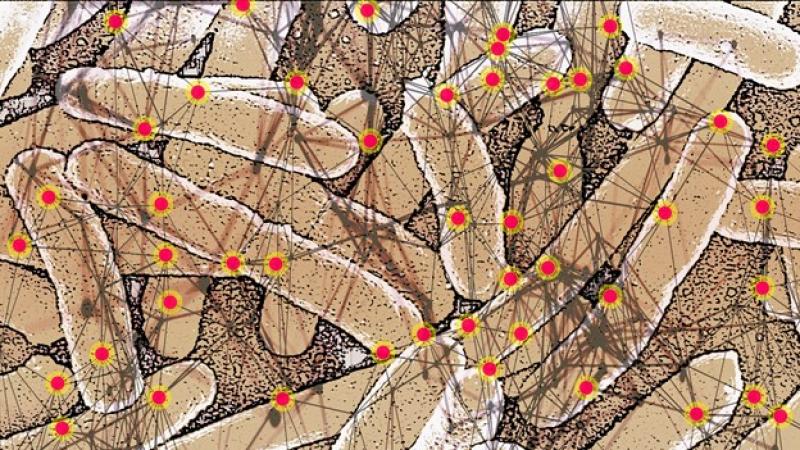
Researchers have identified proteins behind bacterial mutation, paving the way for a sustainable treatment to bacterial diseases.
While several beneficial bacteria live in our guts, some cause deadly diseases like cholera, leprosy, or tuberculosis. Although antibiotics work against such bacteria, there is a reasonable chance that the treatment fails due to widespread antibiotic resistance, especially in developing countries like India. Mycobacterium tuberculosis, the bacterium causing tuberculosis, and Mycobacterium leprae, causing leprosy, have developed resistance to drugs, causing severe challenges to fight these diseases. An alternative approach to dealing with these notorious bacteria could be to use harmless viruses that can kill the bacteria, called bacteriophages.
Phages destroy the bacteria by first infecting them and forcing them to produce their own genetic material instead of creating more bacterial cells. Specific phages have evolved to successfully infect particular bacteria, which in turn have developed various mechanisms to resist the phages. For example, some bacteria can break apart the phage’s genetic material, thus preventing the infection. In contrast, others avoid letting the phage attach to the surface of its cells. Thus, the bacteria’s resistance to viruses stems from mutation, or random changes in the genetic material of the bacteria, facilitated by interacting proteins. In a new study published in the journal Bioinformatics (Oxford), researchers from the Bose Institute, Kolkata, have introduced a mathematical approach to identify the exact proteins responsible for physical changes in the bacteria.
Mycobacterium smegmatis is a bacterium that is genetically very close to Mycobacterium tuberculosis. A phage that successfully infects it is known as D29. With the help of chemicals, the researchers first created a mutated version of Mycobacterium smegmatis. They experimentally demonstrated that this mutated version is resistant to the phage D29. When they looked at the mutated version and the original bacterium under a microscope, they found that the former had shorter cells and a smoother surface than the latter. They also tested how the two reacted to Isoniazid, an antibiotic commonly used to treat bacterial infections. The analysis revealed that the mutated bacterium, resistant to the bacteriophage, was also resistant to Isoniazid. To understand why, the researchers turned to mathematics.
The researchers represented all the proteins that make up the genetic material of Mycobacterium smegmatis in a mathematical framework called ‘networks’. Proteins make up nodes, and the interactions between any two proteins connect the nodes in the network. While one network represented the proteins of Mycobacterium smegmatis, another showed the proteins of the phage-resistant mutant.
“The comparison of networks can identify mutations of any number or kind,” shares Soumen Roy, associate professor of Bose Institute, and an author of the study. It can also compare the genetic makeup of entirely different kinds of organisms.
Then, the researchers devised a mathematical quantity which identifies proteins that interact with other proteins. It examines whether the interactions between protein pairs are routine interactions or signatures of genetic variation. From several hundred thousands of protein pairs, it chooses those that have gone through significant changes to generate the phage-resistant mutant. It enabled the researchers to identify the interactions of exactly those proteins that led to the genetic variations between the two species.
The researchers identified the proteins that give rise to significant alterations in the manner in which cells form their walls, how they divide, how rapidly they conduct metabolism, and how quickly they transport materials within them. Although thousands of proteins make up each bacterium, the researchers also identified which exact combination of these alterations led the bacteria to be resistant to the phage D29.
Other scientists have earlier conducted biological experiments to study mutations of different bacteria. Using their mathematical technique, the team accurately identified the proteins responsible for five well-known mutants.
“We have been contacted by two international groups of researchers for different biological applications of the method,” shares Soumen.
Biologists rely on complicated calculations on computers to study genes that create thousands of proteins. The mathematical method the researchers developed made it possible to significantly simplify the calculations.
“This is a new approach to studying genetic mutations via networks,” asserts Soumen.
Their study was possible because scientists specialising in microbiology and physics worked together to formulate a biological problem in the language of mathematics.
“Quite independent of biology and mutations, network comparison has been an understudied area even in statistical physics,” Soumen signs off.
This article has been run past the researchers, whose work is covered, to ensure accuracy.






